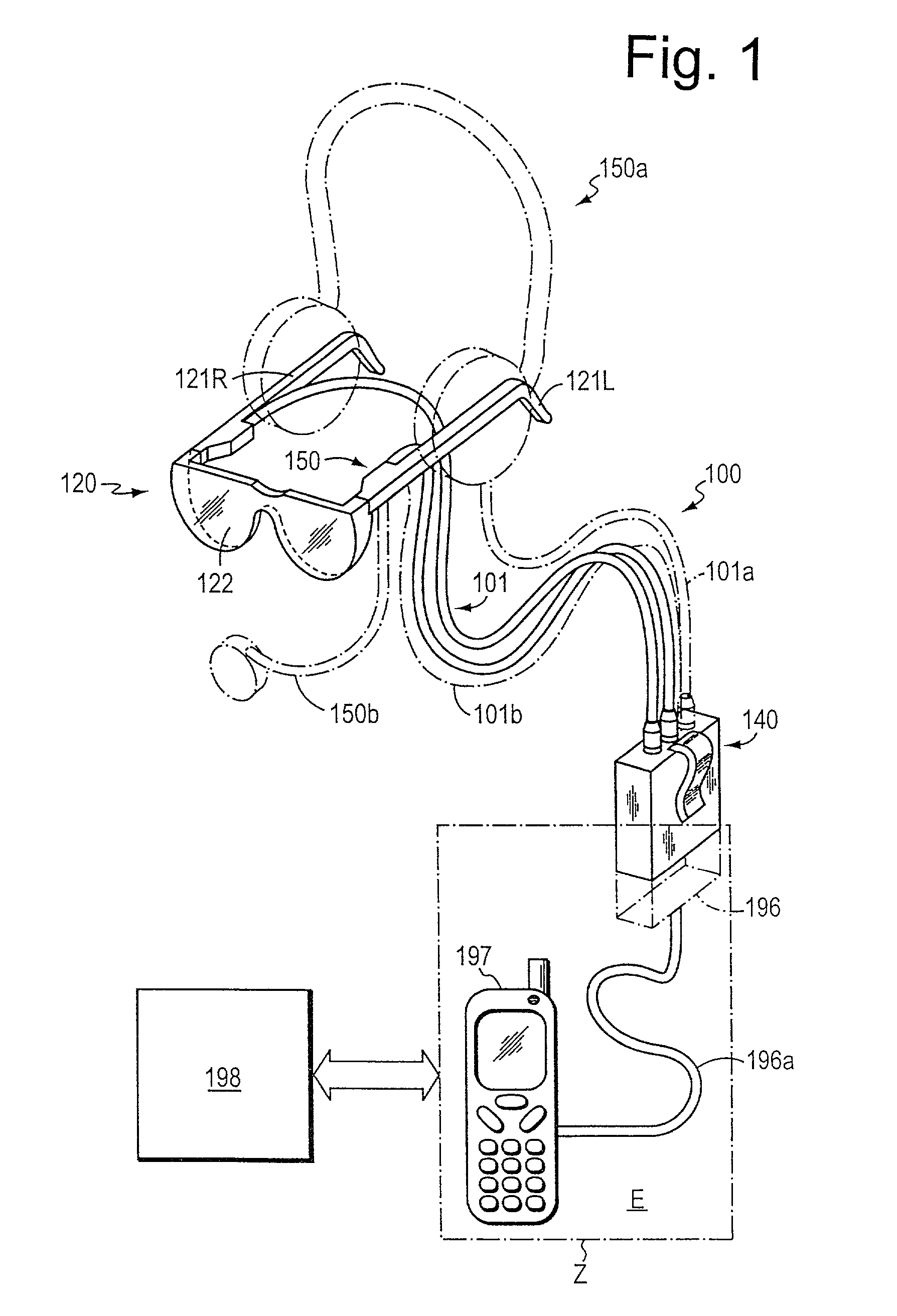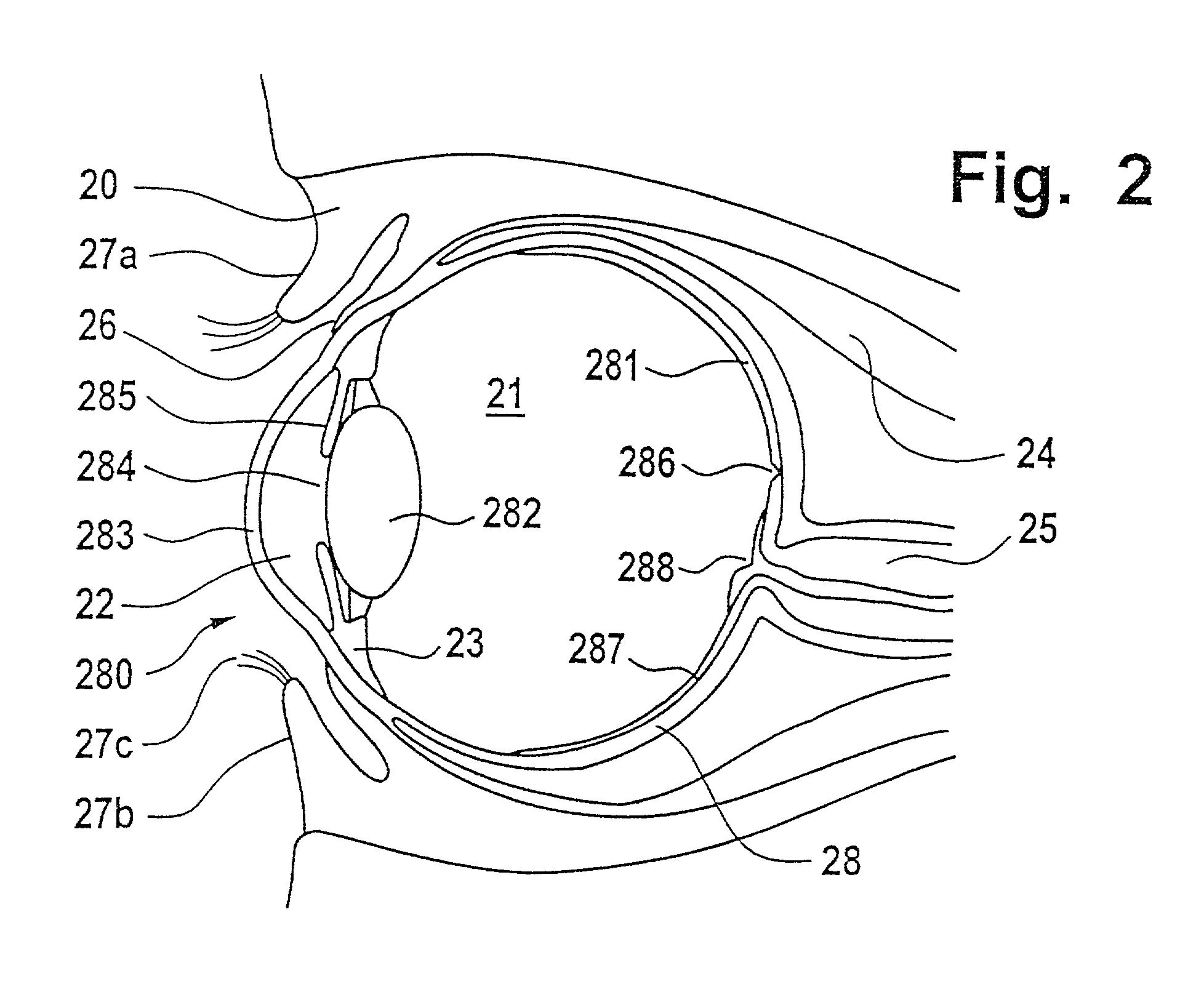[0019]In short, the correlation unit performs the
correlation function that may be “one-to-one” overlap of a scanned and a projected image, or may completely differ from the “one-to-one” overlap, or may include different type of data. For example, the input signal unit may include a
microphone to the external
system, in particular a
directional microphone, which is directed as a function of the
head position or the
gaze direction to allows a further sensory dimension to be realized.
[0036]In accordance with one aspect of the optical input unit, the optical apparatus is wearable by an operator and capable of scanning the
retina up to frequencies of 100 Hz and an image falling onto the eye, in particular a
retinal reflex image. The optical input unit is a part of an interactive
data view and
command system, with the particular
advantage that, for operating the
system, a least possible effort on the part of the operator is necessary. The information to be queried can be transmitted to the operator with shortest possible
delay either in the form of image signals and / or in the form of signals for controlling further information
reproduction devices that can be operated e.g. on an acoustic or other sensory basis. A system thus results that is distinguished by a highest measure of directness of the interactive
information exchange.
[0058]The present system uses the advantages of capturing the
field of view complementary to the capturing of signals reflected back from the eye. For the purpose of such a complementary capturing, the field-of-view capturing apparatus and / or the information apparatus of the
information system in accordance with the invention preferably comprises a spherical or spherical-acting reflection layer that is positioned essentially
confocal to the eye that deflects a part of the light directed onto the eye into a sensor apparatus for capture. Due to the fact that the
reflectivity of the
reflective layer is several times higher than that of the
retinal or
corneal reflex, considerably more light can be captured using equally sensitive photo-sensors. Moreover, correspondingly cheap photo-sensors could be used in the sensor apparatus. It can also be advantageous if the light falling onto the eye is not solely, only partially or not at all captured via the
retinal reflex.
[0066]The present system enables novel ways of correlating and presenting data acquired, computed (manipulated), received via a
wireless communication unit, or from a storage device. Importantly, the provision of information with the signals captured by the signal capturing unit, the system treats the corresponding parts of the captured light during a processing that occurs in the course of the provision of information as if they were
reflex images captured from the eye, i.e., as if they were that which is truly seen. The information system can also combine high quality field-of-view information directly from the truly seen field-of-view information from the eye.
[0074]The optical signal unit or the output unit (or the spectacle apparatus) can determine the position and orientation of at least one eye quickly, accurately and at little expense, e.g. at a determining rate of 100 Hz, a positional accuracy of several micrometers and using a portably constructed apparatus. By using the information during the dynamic evaluation of the orientation of the eye, the processing can be carried out so quickly that the accuracy is not impaired by the saccadic motion of the eye. This is achieved by a signal-capturing unit, which does not contact the eye and captures signals reflected back from the eye. Reflectable signals, e.g., sound or electromagnetic signals, allow a
high frequency capturing such that the processing speed is primarily determined by an evaluation unit. The evaluation unit may have, depending on the application, very high processing speed, low
power consumption and small system size.
[0079]The capturing of the retinal reflex in which the retinal reflex of natural or
artificial light is intermittently or partial captured as the signal reflected back from the eye has turned out to be useful. A full capturing of the retinal reflex is both
time consuming and demanding on performance. On the other hand, a capturing of the retinal reflex is useful inasmuch as it allows the relationship of the perceived
field of view to the
retina to be directly determined. Indeed, as noted above, a processing of the captured retinal reflex allows both retinal features such as e.g. the
fovea centralis or the
blind spot as well as the reflex image of the light falling onto the eye to be determined. The network of blood vessels present in the
choroid coat also becomes visible through appropriate processing of the retinal reflex image, which yields a very good basis for determining the orientation of the eyeball. If the retinal reflex is thus captured intermittently or partially, the processing complexity can be reduced without sacrificing an exact determination of the relationship of the perceived
field of view to the
retina. Naturally, the retinal features can be followed without capturing the retinal reflex. For example, the blood vessels of the
choroid coat can be recognized via their
radiation of heat that is visible in the
infrared range.
 Login to View More
Login to View More  Login to View More
Login to View More 


